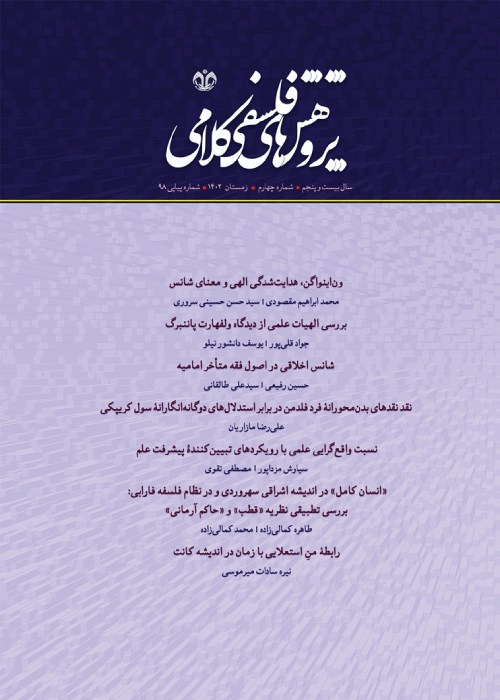Heidegger’s Attitude in Kant and Problem of Metaphysics to the Temporal Aspect of Images in Kant’s Pre-Critique and Critical Period
Author(s):
Article Type:
Research/Original Article (دارای رتبه معتبر)
Abstract:
Kant, in his pre-critical works like Reflections on Anthropology and Lectures on Metaphysics, considers some aspects of images that are not followed in the Critique of Pure Reason. Instead, in the first critique, he makes us face some new aspects act of the imagination. In this research, through the analytic-descriptive method, we study the relationship between time, image, synthesis, in Heidegger’s Kant and the Problem of Metaphysics which can give imagination an ontological aspect. Heidegger also tries to show the coherence and continuity between these two periods, which are not apart from each other. Heidegger’s interpretation relies on syntheses and his references to pre-critical works show the imagination as a unifying faculty for sensibility and understanding and make new images that are related together. He shows in the first critique, that there is a correlation and continuity between the form of presentation, (Darstellung), and the perceptual representations, (Vorstellung). Different images are formed on the ground of the pure image of time and have a direct relation to the synthesis. In addition to this, schema-images are not like perceptual images, but as pure future, are the basis of thought-experience, precisely cognition-intuition. The transcendental schematism is the continuous basis of both experience and thought, which is indeed the common and unknown root between sensibility and understanding of knowledge. The transcendental schematism is the pure time that becomes the basis of our knowledge. It brings together two sources, sensibility and understanding, the two branches of human cognition that perhaps share a common, but to us unknown, root (B 29). Sensibility provides the mind with intuitions it receives from the senses, whereas understanding contains the concepts necessary to process this sensory information. Both forms of knowledge are necessary for all cognition. Now cognition (Erkenntnis) is quite distinct from thought in general. Although it is possible to think (Denken) without sensory information, our concepts remain empty and no cognition has occurred: we have only “played with representations (Vorstellungen)” (B 195). For cognition to occur, all thought must relate, directly or indirectly, to sensibility (B 33): our concepts must be made sensibly concrete. “If cognition is to have objective reality, that is, a connection to an object,” argues Kant, “then the object must be capable of being given in some manner” (B 194). “Being given,” is what Kant means by Darstellung: the horizon of time is representations of object = x. Conceptual representations of the object = x are necessary to cognition. Pure time is a horizon of time that forms different images as images of notions of concepts. By placing the subject and subjective knowledge with Dasein, Heidegger accentuates the horizon of time and holding open the horizon as dasein to others. Dasein creates an image for now and leaves behind the images of throwing possibilities. As a result, the point of intersection of all the discourses can be expressed in such a way that the three Kantian syntheses correspond to the three aspects of time, temporality related to the forms of existence. schema-image is the pure-image-of-time of ontological determinism in the forms of existence. Dasien acts as Kant’s imagination based on images and relations that seem visually pictorial, and performs these relations and creates images. For Heidegger, therefore, imagination means performing the visual-time-relations, which is related to the pure image of time. These pictorial or visual relations refer to seeing or throwing to the form of presenting if something, like x, appears; relationships that make the image of phenomena appear as something and something else. Based on the temporal aspect, we can say the function of imagination is forming to the present, past, and future dimension of time which is corresponded to the dasein’s forms of existence.
Language:
Persian
Published:
Journal of Philosophical Theological Research, Volume:23 Issue: 2, 2021
Pages:
99 to 128
magiran.com/p2326419
دانلود و مطالعه متن این مقاله با یکی از روشهای زیر امکان پذیر است:
اشتراک شخصی
با عضویت و پرداخت آنلاین حق اشتراک یکساله به مبلغ 1,390,000ريال میتوانید 70 عنوان مطلب دانلود کنید!
اشتراک سازمانی
به کتابخانه دانشگاه یا محل کار خود پیشنهاد کنید تا اشتراک سازمانی این پایگاه را برای دسترسی نامحدود همه کاربران به متن مطالب تهیه نمایند!
توجه!
- حق عضویت دریافتی صرف حمایت از نشریات عضو و نگهداری، تکمیل و توسعه مگیران میشود.
- پرداخت حق اشتراک و دانلود مقالات اجازه بازنشر آن در سایر رسانههای چاپی و دیجیتال را به کاربر نمیدهد.
In order to view content subscription is required
Personal subscription
Subscribe magiran.com for 70 € euros via PayPal and download 70 articles during a year.
Organization subscription
Please contact us to subscribe your university or library for unlimited access!


